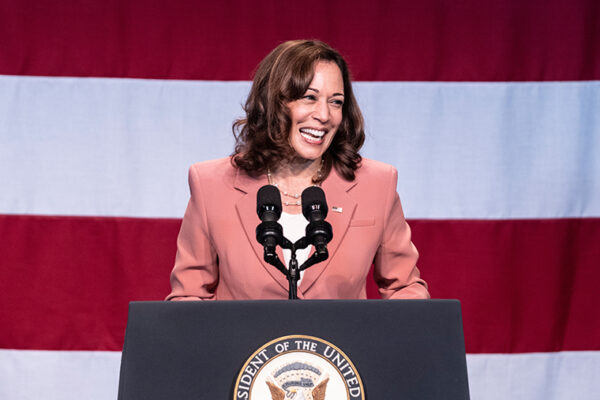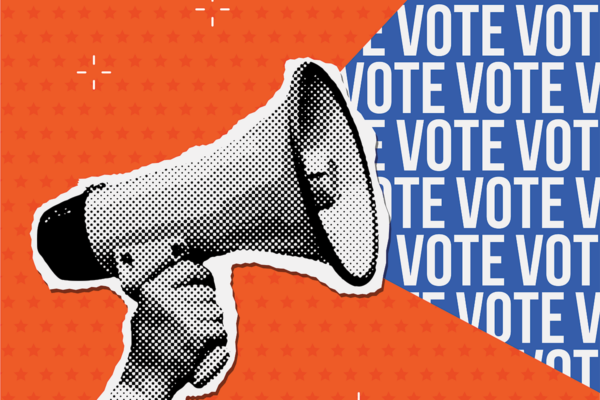Unions are one of the few organizations left that both influence members to vote and influence who they will vote for. The other is churches. So while union membership is declining — today, about one in 10 workers belong to a union, down from about one in three in the late 1950s — they still have a crucial role to play in our politics, according to Jake Rosenfeld, a professor of sociology in Arts & Sciences at Washington University in St. Louis.
For decades, unions have helped propel Democrats to office. Going back to the 1980s, and likely before, a greater share of union households has voted for the Democratic presidential nominee over the Republican nominee, said Rosenfeld, author of “What Unions No Longer Do” and “You’re Paid What You’re Worth and Other Myths of the Modern Economy.”
“At least since the New Deal, many major unions — and their leaders — have been firmly identified with the Democratic Party,” Rosenfeld said. “To take just one example of the close relationship between labor and the Democrats, in the lead-up to the 1944 election, FDR reportedly told aides deciding on a vice-presidential pick to “clear it with Sidney” — Sidney being Sidney Hillman, president of the International Ladies Garment Workers Union and a close adviser to the president.”
There’s evidence, however, that the close ties Democrats have enjoyed with unions are weakening.
“Unions represent a vast array of very different types of workers who vary in their political preferences. And union leaders’ political persuasion skills aren’t absolute — many union workers will buck their unions’ endorsements at the polls this year, as they have in past elections,” Rosenfeld said.
“It’s easy to overstate the close alliance between unions and the Democrats despite the fact that many union members, and certain unions themselves — especially protective service ones — vote Republican and endorse Republican candidates. The Teamsters — in the news recently after its president spoke at the Republican National Convention — have repeatedly endorsed the Republican presidential candidate.”
So while several unions, including the United Auto Workers and the American Federation of Teachers, have already endorsed Vice President Kamala Harris, the millions of workers they represent are still, in many cases, undecided. Ultimately, union voters could be the deciding factor in this year’s presidential election.
Below, Rosenfeld discusses Republican efforts to attract union voters, compares Biden’s and Trump’s records with unions and looks ahead to the 2024 election.
What are some reasons why union members might be shifting their votes? How are Republican politicians responding?
The changing class composition of the electorate comes immediately to mind. As Republicans have made inroads among non-college educated voters, they’ve been able to cleave off a segment of union voters.
But here again it’s easy to overstate the trend: roughly half of the unionized workforce today is employed in the public sector, and public-sector workers are significantly more likely to have a college degree (or higher) than their private-sector counterparts. The ranks of the college educated have trended toward the Democrats.
Still, this shift has attracted the notice of a segment of Republican officeholders eager to court working-class votes. One clear example here is Missouri’s Sen. Josh Hawley, who recently switched his position on right-to-work legislation from anti- to pro-union. He also joined a picket line during last year’s autoworker strikes — something you wouldn’t have seen five or 10 years back by prominent Republican officeholders. He’s not alone, either — other senators like J.D. Vance, now Trump’s running mate, and Marco Rubio have expressed limited support for labor.
This support remains highly circumscribed, however. The Republican Party remains united in opposition to public-sector unions — with the partial exceptions of police and firefighters. That’s about half of the unionized workforce that remains in their crosshairs as we approach the 2024 race.
The Biden administration has claimed to be the most pro-union administration in recent history. Do you agree?
Yes, wholeheartedly. Some of the support has been symbolic, such as when Biden marched alongside striking autoworkers last fall in Michigan or hosted young leaders of upstart organizing efforts at Starbucks and Amazon at the White House. The presidency is quite limited in what it can do to advance pro-union legislation without the support of Congress, and the administration’s top policy to strengthen unions — the Protecting the Right to Organize Act — never made it out of the Senate.
But working around the congressional impasse, Biden fired the Trump-appointed general counsel of the National Labor Relations Board (NLRB) and installed Jennifer Abruzzo, who has steered the board in a much more union-friendly direction. Major pieces of legislation, including the CHIPS Act, contain provisions that provide incentives for hiring unionized labor on new projects.
How does this compare to Trump’s first term?
Despite examples of campaign rhetoric, when it came to issues relevant to labor, Trump governed as a typical Republican president: He appointed a secretary of labor and NLRB head hostile to union interests, stacked the judiciary with anti-union judges, and took no major steps in pushing for legislation that would advance labor’s reach. The one slight exception here might be trade policy, where a more protectionist stance could strengthen domestic manufacturers. The issue is that so few domestic manufacturers remain unionized, and the private sector unionization rate continued to decline throughout Trump’s term.
What could voters expect from Kamala Harris’ administration if she wins in November?
Certainly, much of organized labor is hoping for an extension of Biden’s administration! Harris chaired the administration’s Task Force on Worker Organizing and Empowerment, an effort to identify pathways to increase unions’ reach and influence. Given her short term in the Senate prior to her vice presidency, much remains to be seen about how much emphasis she would place on labor issues in a Harris presidency.



